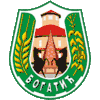Crna Bara, Bogatić
Crna Bara (Serbian Cyrillic: Црна Бара) is a village in Serbia, in the Mačva region. Administratively it belongs to the municipality of Bogatić. According to the 2002 census, the village had 2,270 residents.[1] It lies near the confluence of Drina river into Sava.
Crna Bara
| |
|---|---|
 Crna Bara | |
| Country | |
| Statistical Region | Šumadija and Western Serbia |
| Region | Mačva |
| District | Mačva District |
| Municipality | Bogatić |
| Time zone | UTC+1 (CET) |
| • Summer (DST) | UTC+2 (CEST) |
Geography
The village is in the far northwest of Mačve, located at the mouth of the Drina River in Savu. Farmland is about 2.772 - {ha} - of which the major part is located in a floodplain where the Drina and Sava rivers during floods and covered more than 2,000 acres.
The village is populated urban type with 19 streets and 4 correct intersection. All streets in the village are paved and street lighting covered about 30% of the settlements. Field roads are in very good condition.
History
Famous people from Crna Bara include the Serbian historian Miloš Milojević and Serbian soldier Vuk Isaković. Milojević (Crna Bara, Principality of Serbia, 16 October 1840 - Belgrade, Kingdom of Serbia, 24 June 1897) was a Serbian historian, politician and writer.
Janko Veselinović, a writer, wrote the novel Hajduk Stanko: historical novel in three parts, in 1896, with the action taking place in the Montenegro Bari
Culture and contemporary life

In the village there is an eight-year-old school " Janko Veselinović" with a branch in Glogovac and Sovljak, St. Vaznesenija ( village celebrates the Spasovdan ), a post office with an automatic telephone exchange with over 600 subscribers, health center, veterinary station.
Cultural event "Hajdučke večeri" is held every year in early August. It was once one of the biggest cultural events in the country, gathering up to 100,000 visitors.
The village was in 1735. The St. George 's church was consecrated 1732nd year for which awareness is credited Vuk Isakovič .[2]
Demographics
In the village of Crna Bara live 1836 adult population, and the average age is 42.4 years (41.6 for men and 43.1 for women). The village then had 683 households, and the average number of persons per household was 3.32.
This village is almost entirely populated by Serbs (according to the 2002 census), and in the last three censuses, there was a decline in population.
The village has 680 households and 988 houses, as there are many abandoned houses, and there are plenty of weekend houses in two-weekend settlements "Vasin Šib" on the Drina (has electricity) and "Confluence" at the confluence of the Drina and Sava rivers (without electricity).
Tourism
An area along the bank of the Drina, named "Vasin Šib" developed into the weekend-settlement. It has a hotel "Cer", motel "Mačvanska kuća", several restaurants and bungalows. Several sports fields are also built.[3]
See also
References
- Popis stanovništva, domaćinstava i stanova 2002. Knjiga 1: Nacionalna ili etnička pripadnost po naseljima. Republika Srbija, Republički zavod za statistiku Beograd 2003. ISBN 86-84433-00-9
- "St. George in the village of Hajduk Stankov ( "Serbian nasleđnje ", November 1998. )". Archived from the original on 2014-01-09. Retrieved 2014-02-02.
- Aleksandra Kurteš (2 July 2017), "Najstarije selo u Mačvi", Politika-Magazin No. 1031 (in Serbian), pp. 26–27
